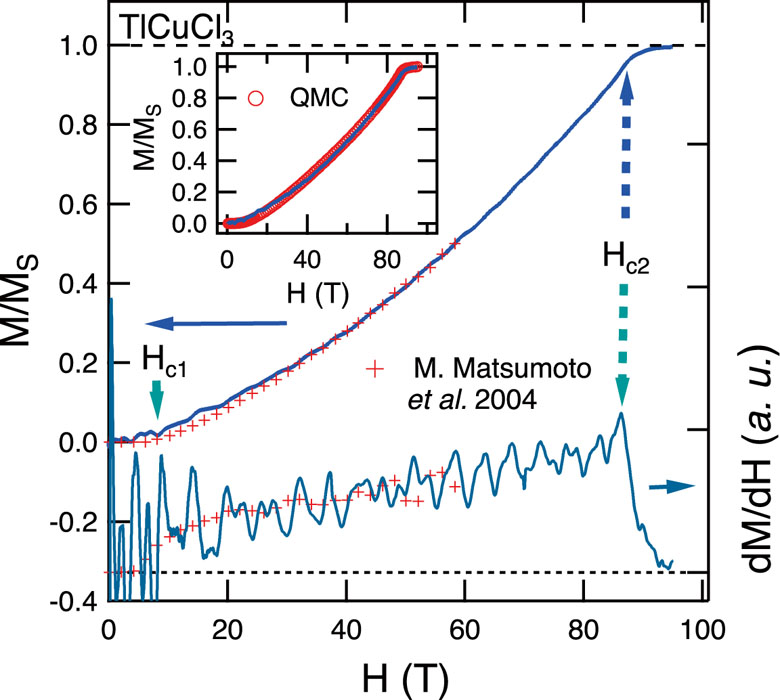Particle-Hole Symmetry Breaking in a Spin-Dimer System TlCuCl3 Observed at 100 T
Y. H. Matsuda and Kindo Group
In a pure dimer system, the transition between singlet state and the Sz = 1-triplet state under an external magnetic field drives a phase transition at the critical magnetic field Hg ≡ Δ/gμB with Δ the spin gap. The Hg separates into two distinct critical points Hc1 and Hc2 in real spin-gap materials due to interdimer interactions; these two critical magnetic fields correspond to the beginning and saturation of the magnetization, respectively. It has been proposed that the field-induced ordering phase at Hc1 in the dimer system with finite interdimer interactions (a three-dimensional S = 1/2 spin-gap dimer system) can be interpreted as a Bose-Einstein condensation (BEC) phase of magnons [1]. For a long time, this field-induced ordering phase at Hc2 was thought to be the BEC phase of holes of magnons [2], e.g., the magnetic-field dependence of the order parameters in phase diagrams has a symmetry with respect to the particle-hole invariant point H = (Hc1 + Hc2)/2. However, the universality of this symmetry has been questioned in strong interdimer interaction system.
In present work, we study the magnetization (M) process of TlCuCl3 (a strong interdimer interaction spin system) up to 100 T and discuss the particle-hole symmetry breaking of the BEC phase [3]. Figure 1 shows the magnetization process and the magnetic field dependence of the dM/dH at 2 K; the magnetization data simulated by the quantum Monte Carlo (QMC) calculation is also presented for the comparison of the M-H curves. The magnetization curve (M-H curve) has a monotonous convex downward shape, which manifests the difference between the critical behaviors around Hc1 and Hc2 and implies the absence of the particle-hole symmetry in TlCuCl3.
The breaking of symmetry can be simply understood in the bond operator theoretical formalism. The magnetism around Hc1 is contributed to by the outset of lowest triplet |↑↑>, namely, Sz = 1 condensations driven by the vanishing spin gap. In the pure-dimer limit Jintra >> Jinter, the other two higher-energy local excitations (|↑↓> + |↓↑>) and |↓↓> can be neglected since they hardly affect the low-temperature physics. However, a finite Jinter interaction can mediate a four-particle interaction that accumulates highest-triplet |↓↓> excitations in the presence of a partial lowest-triplet condensation and singlet condensation [4]. Therefore, |↓↓> excitations suppress the magnetization from the |↑↑> condensations when H ≳ Hc1. When the magnetic field increases beyond Hc1, such a suppression eventually becomes inefficient due to a large Zeeman gap to excite a |↓↓> quasiparticle and is negligible near Hc2. Therefore, it can be concluded that the particle-hole symmetry in the weak interdimer spin system is broken in TlCuCl3 due to the strong higher-order terms through the interdimer interactions.
References
- [1] T. Nikuni, M. Oshikawa, A. Oosawa, and H. Tanaka, Phys. Rev. Lett. 84, 5868 (2000).
- [2] M. Jaime, V. F. Correa, N. Harrison, C. D. Batista, N. Kawashima, Y. Kazuma, G. A. Jorge, R. Stein, I. Heinmaa, S. A. Zvyagin, Y. Sasago, and K. Uchinokura, Phys. Rev. Lett. 93, 087203 (2004).
- [3] X.-G. Zhou, Y. Yao, Y. H. Matsuda, A. Ikeda, A. Matsuo, K. Kindo, and H. Tanaka, Phys. Rev. Lett. 125, 267207 (2020).
- [4] M. Matsumoto, B. Normand, T. M. Rice, and M. Sigrist, Phys. Rev. B 69, 054423 (2004).

